Ecology
...now browsing by category
Friday, April 22nd, 2016
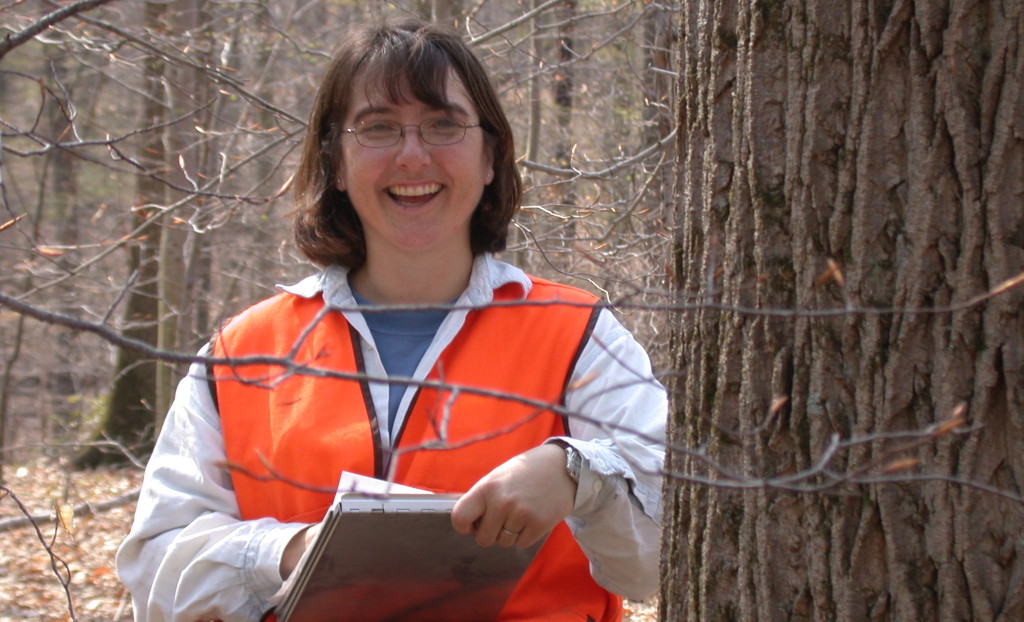
Ecologist Dawn Miller in SERC forest (SERC)
by Kristen Minogue
Friday is Earth Day, and this year it’s all about the trees. The Earth Day Network is on a mission to plant 7.8 billion trees in five years. Trees have enormous power when it comes to protecting the Earth. Scientists at the Smithsonian Environmental Research Center (SERC) have spent decades uncovering the environmental benefits of forests. But trees offer some advantages that are less obvious. Like acting as painkillers. Or improving your morning coffee. Since the holiday falls on April 22, we picked our top 22 things trees do for humanity. Click to continue »
Posted in Climate Change, Ecology | 17 Responses »
Wednesday, March 30th, 2016
by Heather Soulen
Sonic Cacophonies
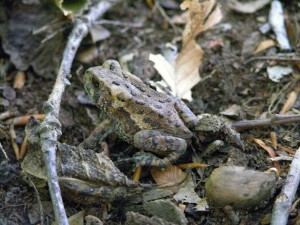
American Toad (Photo: Tyler Bell)
It’s that time of year when much of the mid-Atlantic is waking up from a long winter’s slumber. Flowers are blooming, trees are budding, ospreys and eagles are nesting, and frogs are calling. Right now, the Smithsonian Environmental Research Center (SERC) is alive with the sonic cacophony of a two amphibians. Spring peepers (Pseudacris crucifer) and American toads (Anaxyrus americanus, formerly Bufo americanus) are shouting mating anthems from every available pocket of water. If you live east of the Mississippi River from Canada to Florida, you’ve likely heard their calls. But which is which? We’ve collected a few sound bites around SERC to help identify each amphibian’s call.
Click to continue »
Posted in Ecology, Education, SERC Sites and Scenes | Comments Off on Amphibian Congregation: Sonic Songs of Spring
Tags: American toads, amphibians, animal calls, frogs, mating, spring, spring peepers, wildlife
Thursday, February 11th, 2016
by Jan Payne Wilson, SERC Volunteer
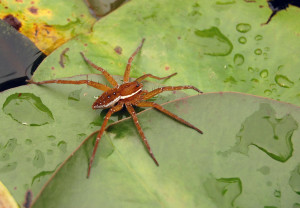
Six-spotted fishing spider, Dolomedes triton. Credit: Derek Ramsey
My dad was uncomfortable around spiders. Today we’d probably say he had a phobia. To deal with it, he found a spider-like creature, the Daddy Long Legs, and learned how benign and beneficial it was. From then on, he could focus on a “good spider” rather than his fear. As a child, I was indoctrinated with the knowledge that a Daddy Long Legs 1) could not bite you and 2) performed good deeds by eating “bad” spiders and other biting, child-frightening insects. Furthermore, they needed our help because they had delicate legs that easily broke off, so we moved them out of dangerous areas and avoided stepping on them. When I was older my father revealed that Daddy Long Legs weren’t actually spiders. Unlike true spiders, they can’t make silk and have neither fangs nor venom. From my father I learned that understanding a creature often changes fear into appreciation and, sometimes, amazement.
On the docks of the Smithsonian Environmental Research Center (SERC), I use my dad’s strategy to help students who either fear spiders or believe the only good spider is a dead spider. With Daddy Long Legs it’s easy. But we also have large spiders we don’t see as frequently: fishing spiders. When you see your first fishing spider, it’s a hard sell to believe she’s got redeeming characteristics. Click to continue »
Posted in Ecology, Education, SERC Sites and Scenes | Comments Off on The Everyday Naturalist: Fishing Spiders
Wednesday, February 3rd, 2016
by Kristen Minogue
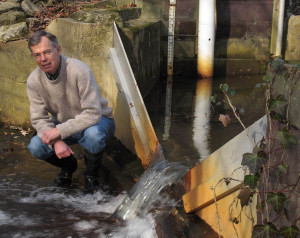
Tom Jordan beside a V-shaped weir that tracks nutrients in a SERC stream. (SERC)
For years, a team of scientists has been trying to solve a mysterious disappearance at a drainage ditch on the Choptank River Basin, on Maryland’s eastern shore. Every year roughly 32,000 pounds of human-generated nitrogen enters the ditch’s watershed, from fertilizers, air pollution and other sources. But less than a third of that nitrogen typically flows out of the stream.
Tom Jordan has seen it before. A nutrient ecologist at the Smithsonian Environmental Research Center (SERC), Jordan has wrestled with the mystery of the missing nitrogen for more than twenty years.
“It feels like a sort of fatal attraction,” Jordan said. Two decades of trial and error and dead ends only fueled his determination to find answers. Now, according to a new January study, Jordan and his colleagues finally have some.
Click to continue »
Posted in Ecology, Land Use, Publications, Water Quality | 2 Responses »
Thursday, December 31st, 2015
by Kristen Minogue
It’s been another wild year at the Smithsonian Environmental Research Center. We sent a sailboat to the Arctic, pitted our orchids in a showdown against the Hope Diamond and discovered a couple new species. And somewhere along the way we celebrated the center’s 50th anniversary. Scroll below for the 2015 #YearInReview, a collection of the top 12 stories, journeys and biggest surprises of 2015.
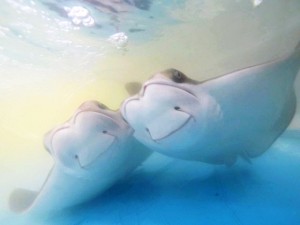
Cownose Rays (SERC/Laura Patrick)
Exploring the Ocean
Totes Adorbs! Cownose Rays Take Internet
These marine heartthrobs have earned a top billing. Besides making a 900-mile migration every year, which SERC marine ecologists are tracking with acoustic tags, the kite-shaped rays (whose mouths are stretched so that they seem to be wearing a perpetual smile) also won a Twitter #CuteOff in September.
What Does Life in the Ocean Sound Like?
Postdoc Erica Staaterman listens to the ocean for a living. Often seen as a silent landscape broken only by whale or dolphin songs, Staaterman is helping uncover a wealth of noise from the ocean’s hidden creatures. She shared some of the recordings with us in this edited Q&A.
Cruising the Arctic’s Forgotten Fjords
Ocean acidification researcher Whitman Miller sent one of his CO2-monitoring devices on a 100-day journey to the Arctic. Its mission: Venture to some of Greenland’s never-before-seen fjords and discover how melting glaciers are changing the water. And do it all in a small, 42-foot sailboat. Click to continue »
Posted in Climate Change, Ecology, Fisheries, Invasive Species, SERC Sites and Scenes, Water Quality | Comments Off on Top 12 Highlights of 2015: Arctic Sailing, Cownose Rays and an Orchid Showdown
Tuesday, December 22nd, 2015
by Kristen Minogue
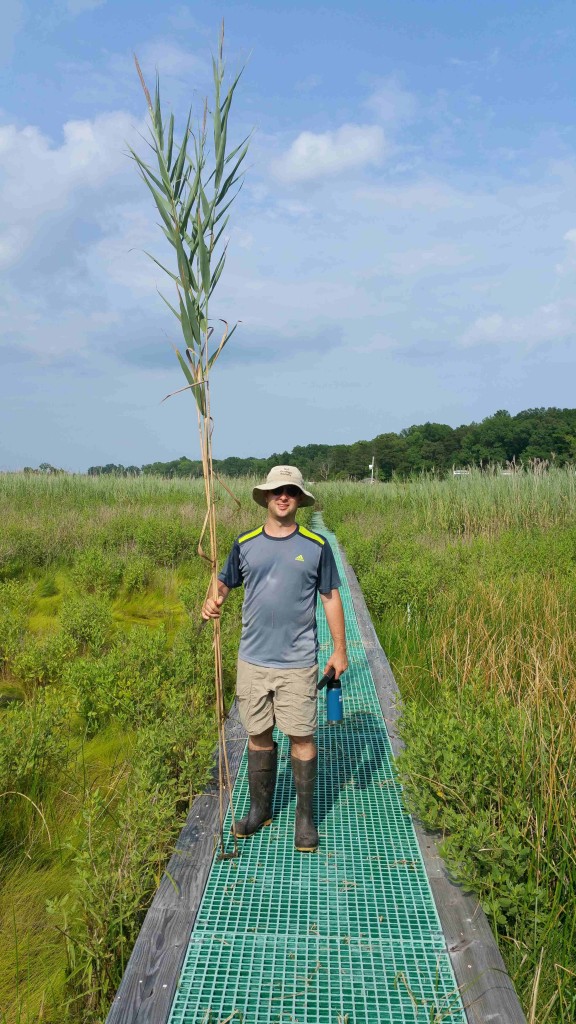
Ecologist and lead author Josh Caplan holds a Phragmites plant at the Global Change Research Marsh. Invasive Phragmites can grow up to 15 feet tall. (Thomas Mozdzer)
One of the Chesapeake’s least favorite invaders could end up being an unlikely savior. The invasive reed Phragmites australis, a plant that has exploded across Chesapeake wetlands in the last few decades, is also making those wetlands better at soaking up carbon, ecologists from the Smithsonian Environmental Research Center (SERC) and Bryn Mawr College discovered in a new study.
The common reed, better known as Phragmites australis, grows in dense clusters up to 15 feet tall. North America has several native strains that have co-existed peacefully with many other native plants for at least 30,000 years. It is the invasive strain that arrived from Eurasia in the 1800s that has scientists and environmental managers worried. Eurasian Phragmites grows taller and denser than North American Phragmites, crowding out many smaller plants, and blocking access to light and nutrients. These changes in plant community have a ripple effect on animals that rely on wetlands for habitat.
“The fish communities, the insect communities, the soil and invertebrate communities, all these things change when Phragmites comes in,” says lead author Josh Caplan, a Bryn Mawr postdoc and visiting scientist at SERC. Often, those changes aren’t for the better. “Phragmites is doing a number to these ecosystems.” Click to continue »
Posted in Climate Change, Ecology, Invasive Species, Land Use, Publications, SERC Sites and Scenes | Comments Off on Phragmites vs. Climate Change: Invasive Reed Better at Taking Up Carbon
Thursday, December 17th, 2015
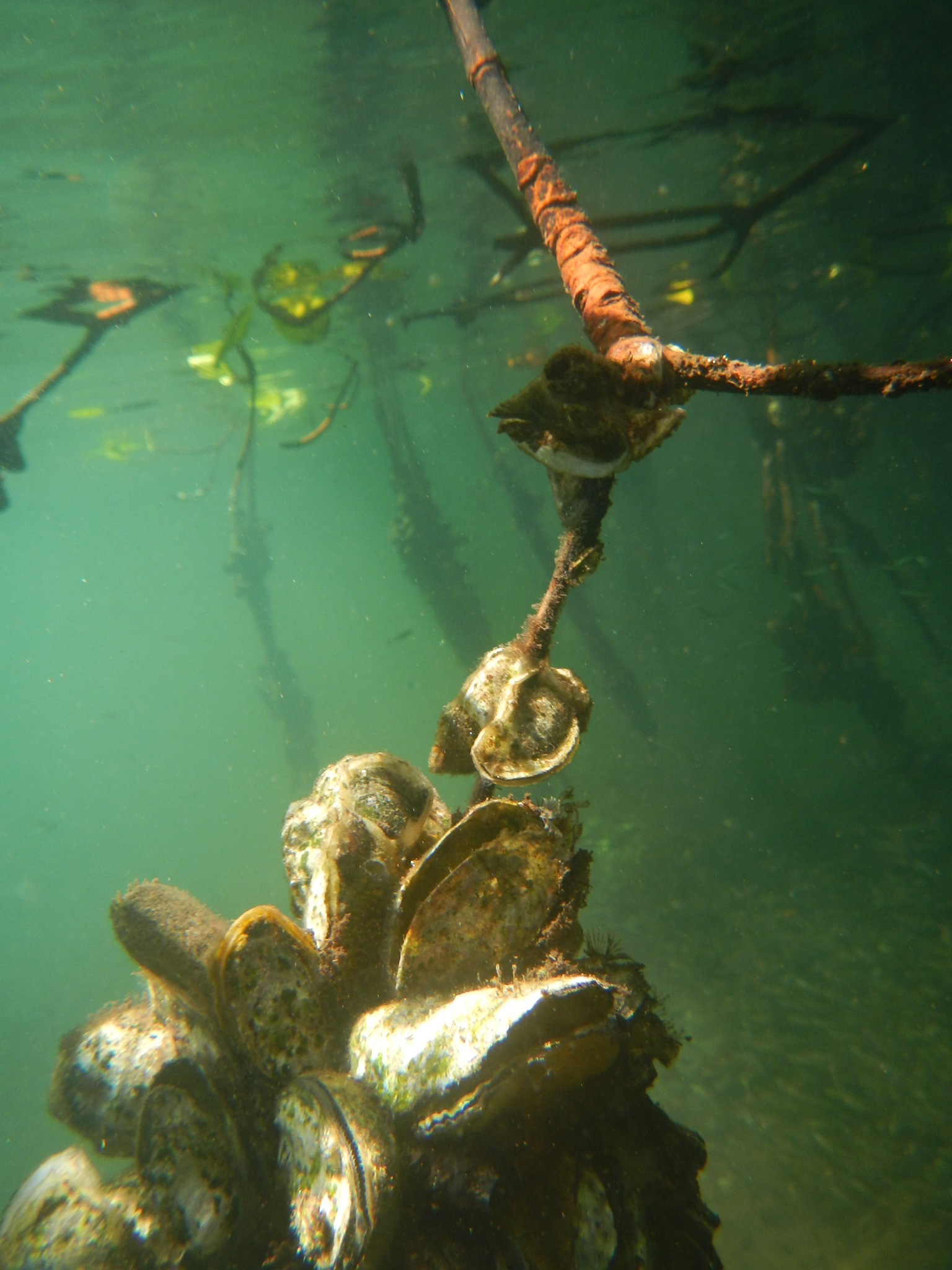
Bivalves from Panama for Dermo disease study
by Heather Soulen
Last week Nature magazine published a news piece about how supplies of agar, a research staple in labs around the world, are dwindling. Agar is a gelatinous material from red seaweed of the genus Gelidium, and is referred to as ‘red gold’ by those within the industry. Insiders suggest that the tightening of seaweed supply is related to overharvesting, causing agar processing facilities to reduce production. Most of the world’s ‘red gold’ comes from Morocco. In the 2000s, the nation harvested 14,000 tons per year. Today, harvest limits are set at 6,000 tons per year, with only 1,200 tons available for foreign export outside the country. In typical supply and demand fashion, distributor prices are expected to skyrocket. As a result, things could get tough for scientists who use agar and agar-based materials in their research.
Agar is a scientist’s Jell-O. Just like grandma used to make Jell-O desserts with fruit artfully arranged on top or floating in suspended animation within a mold, scientists use agar the same way. Bacteria and fungi can be cultured on top of nutrient-enriched agar, tissues of organisms can be suspended within an agar-based medium and chunks of DNA can move through an agarose gel, a carbohydrate material that comes from agar. Agar and agar products are the Leathermans of the science world.
Click to continue »
Posted in Climate Change, Ecology, Fisheries, Invasive Species, Parasite Hunting, Publications | Comments Off on Restrictions in Seaweed Agar-vate Scientists
Tags: agar, agarose, bivalves, clams, Dermo, disease, DNA, ecology, endobacteria, fungi, fungus, gel, marsh, microbiome, nutrient pollution, Orchid, oysters, parasites, Perkinsus, Phragmites, science, seaweed, Spartina
Wednesday, November 25th, 2015
New report enables creation of carbon credits for restored wetlands
by Kristen Minogue
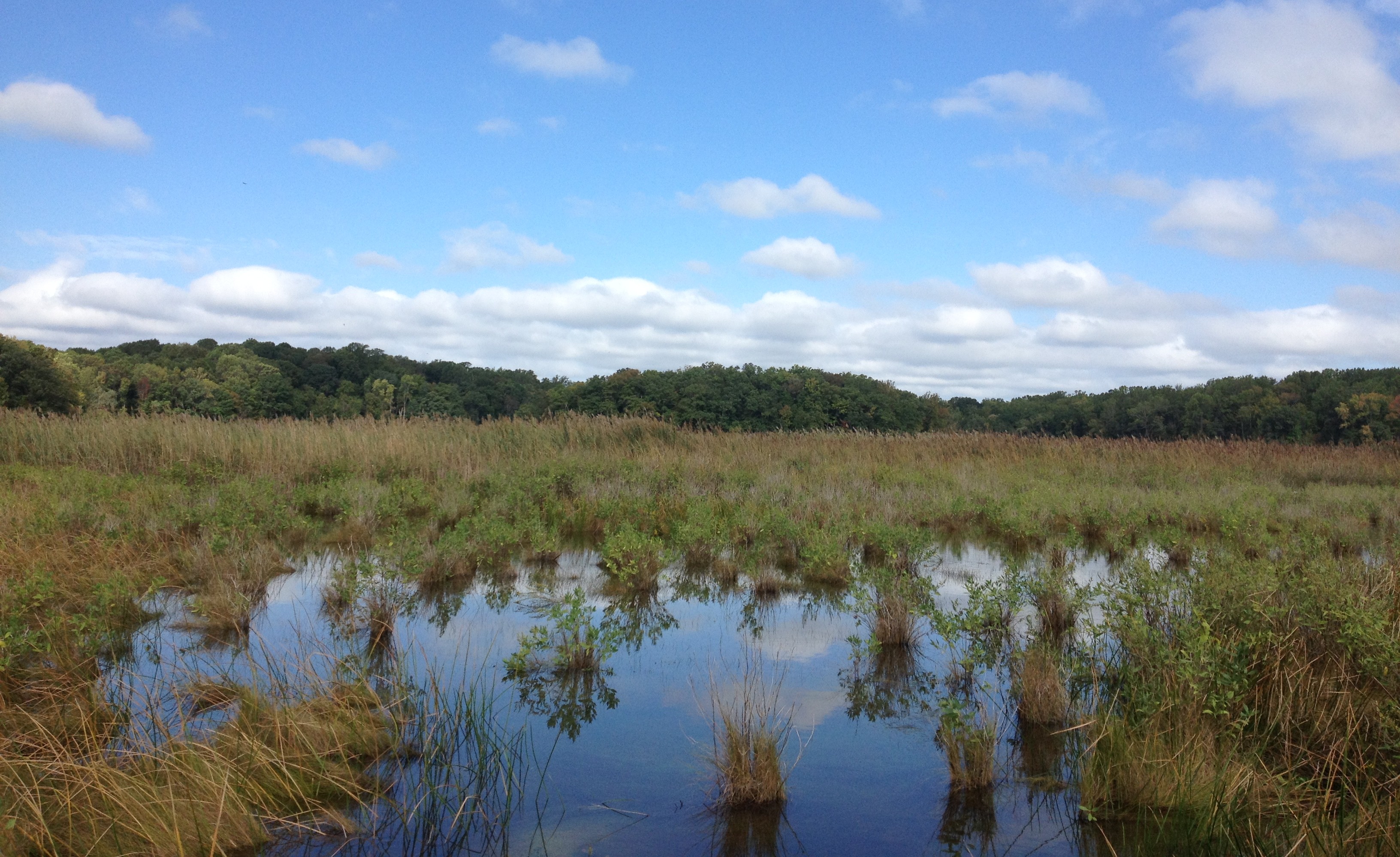
SERC’s Global Change Research Wetland (Credit: SERC)
How much is a wetland worth?
It’s a question that has plagued policymakers, scientists and other leaders looking to protect their communities and slow down the pace of climate change. For the first time, thanks to a new report released Tuesday, scientists have a method to calculate how much greenhouses gas emissions a restored wetland can offset that can be used anywhere in the world–which will allow the creation of carbon credits. Click to continue »
Posted in Climate Change, Ecology, Publications | Comments Off on The Blue Carbon Market Is Open
Monday, November 16th, 2015
by Kristen Minogue

Frozen methane bubbles in an Alaska lake. When icy permafrost thaws, microbes are able to consume the carbon stored there and turn it into methane gas. (Miriam Jones/USGS)
We’ve underestimated greenhouse gases. Not carbon dioxide, arguably the most famous greenhouse gas except water. But others, like methane, are less abundant but more powerful in terms of trapping heat. And our figures about that have probably skewed low.
Carbon dioxide (CO2) comprises a staggering three-fourths of global greenhouse gas emissions, making it a major driving force behind climate change. But methane (CH4), long locked in Arctic permafrost, is escaping as ice thaws. Methane also enters the atmosphere via natural gas, livestock, coal mining, oil and even wetlands.
For years scientists and policymakers have reported that methane is roughly 30 times more powerful than CO2 over a century. This fall, two biogeochemists tested a more accurate model and discovered the true figure is far higher – more like 45 times more powerful than CO2.
The good news? Taking methane out of the atmosphere makes an even bigger difference than putting it in. Click to continue »
Posted in Climate Change, Ecology, Publications | 4 Responses »
Tuesday, November 10th, 2015
by Heather Soulen
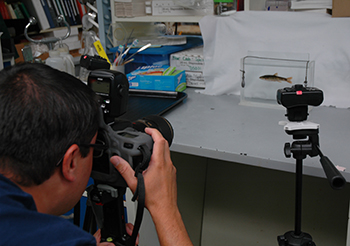
Rob Aguilar takes photos of all DNA barcoding reference specimens they collect in the Chesapeake Bay
Rob Aguilar of SERC’s Fish and Invertebrate Ecology Lab co-authored a DNA barcoding paper this past September in the journal Environmental Biology of Fishes. Rob spoke with us about his paper and the DNA barcoding work going on in the Fish and Invertebrate Lab. While the term DNA barcoding may seem difficult to understand, it’s easiest to think about it as a uniquely identifiable species level code.
Click the sound file below to listen to the interview.
Additional barcoding details are available in the full podcast transcript.
Click to continue »
Posted in Ecology, Fisheries, Interviews, Invasive Species, Publications | 1 Response »
Tags: barcoding, catfish, DNA, fish, invasive species, predator











